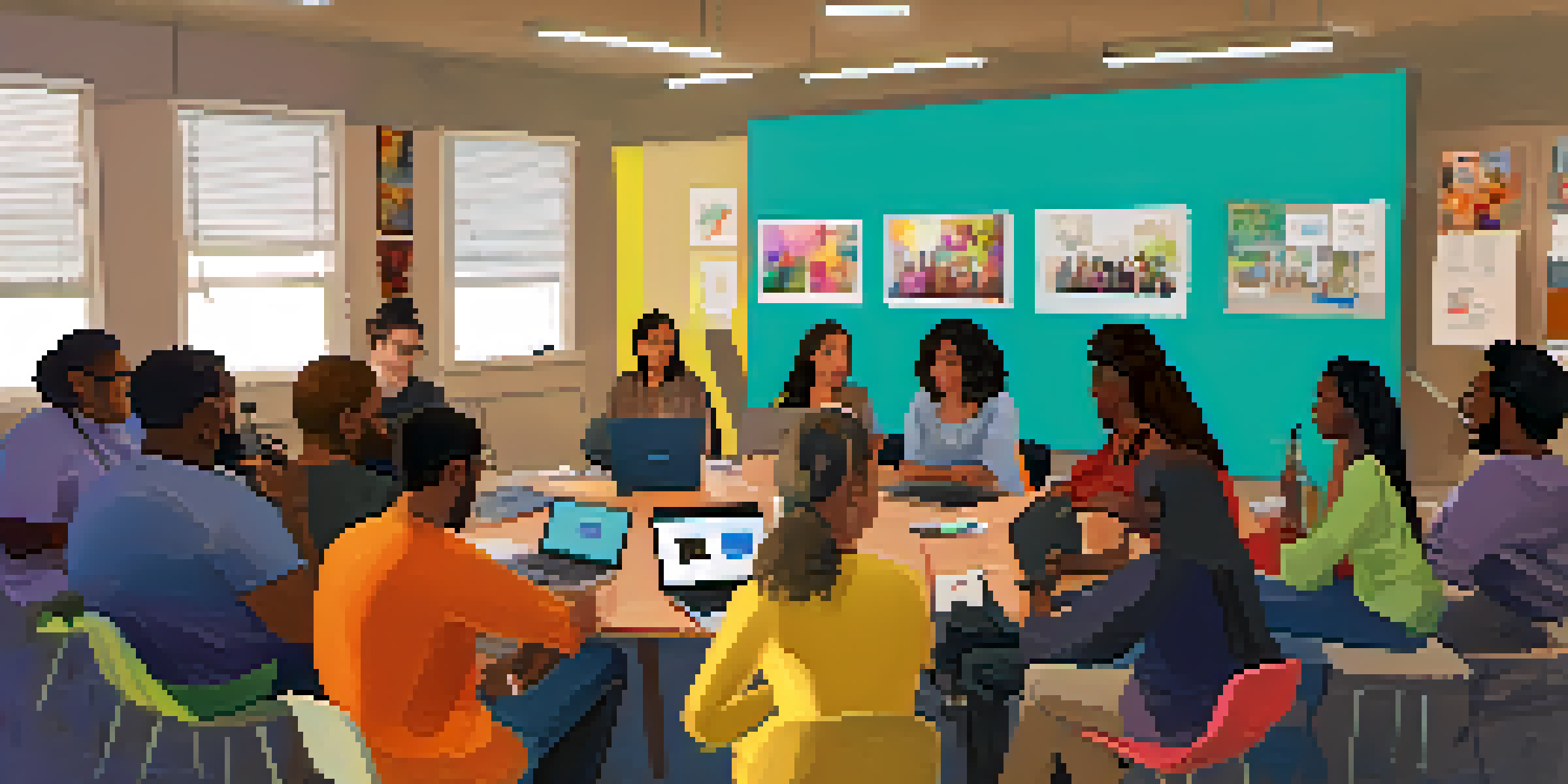Building Empathy Through Digital Storytelling Techniques

Understanding Digital Storytelling and Its Impact
Digital storytelling combines traditional storytelling techniques with digital tools to convey experiences and emotions. By utilizing multimedia elements like images, videos, and audio, it creates a richer narrative that resonates deeply with audiences. This approach not only entertains but also fosters a sense of connection, making it a powerful medium for building empathy.
Storytelling is the most powerful way to put ideas into the world today.
When we share stories digitally, we invite others into our experiences, allowing them to see the world through our eyes. This immersive experience can break down barriers and challenge preconceived notions, leading to a greater understanding of diverse perspectives. In a world increasingly driven by technology, digital storytelling has become a vital tool for human connection.
Moreover, the interactive nature of digital platforms encourages engagement, enabling audiences to reflect on their own experiences. This engagement can lead to meaningful conversations, promoting empathy as individuals connect over shared emotions and stories. Ultimately, digital storytelling serves as a bridge, linking people across different backgrounds and experiences.
Crafting Authentic Narratives That Resonate
To build empathy through digital storytelling, authenticity is key. Authentic narratives resonate because they reflect real emotions, struggles, and triumphs, making it easier for audiences to relate. When storytellers share their genuine experiences, it allows listeners to connect on a deeper level, fostering an empathetic response.

Consider the power of personal anecdotes—when someone shares a moment of vulnerability, it can evoke empathy and understanding. For instance, a video diary about overcoming a challenge can inspire others facing similar issues to feel seen and understood. This emotional connection cultivates a sense of community, where individuals feel empowered to share their own stories.
Digital Storytelling Builds Empathy
By combining traditional techniques with multimedia elements, digital storytelling fosters a deeper emotional connection and understanding among audiences.
Additionally, using relatable characters and situations in digital storytelling can enhance empathy. When audiences see themselves in the narratives being shared, it creates a shared emotional experience, making it easier for them to empathize with others' realities. Crafting these authentic narratives is crucial for effective digital storytelling.
Leveraging Multimedia to Enhance Emotional Impact
Multimedia elements play a significant role in digital storytelling, as they add layers of emotional depth to narratives. By incorporating visuals, sound, and text, storytellers can evoke feelings that resonate with audiences on a visceral level. For example, a poignant photograph can convey a sense of loss that words alone may struggle to express.
Empathy is about finding echoes of another person in yourself.
Think of a documentary that combines interviews, music, and imagery to narrate a compelling story. The synergy of these elements can amplify the emotional impact, inviting viewers to engage more deeply with the content. This multi-sensory approach not only captivates but also encourages empathy as audiences become emotionally invested in the stories being told.
Moreover, the use of technology, such as virtual reality, can take empathy-building to new heights. By immersing individuals in different environments, they can experience situations from diverse perspectives, fostering a profound understanding of others' lives. This innovative use of multimedia is a game-changer in the quest to build empathy through storytelling.
Creating Safe Spaces for Sharing Stories
For storytelling to foster empathy, it’s essential to create safe spaces where individuals feel comfortable sharing their narratives. These environments encourage openness and vulnerability, allowing people to express their thoughts and emotions freely. When audiences know they are in a judgment-free zone, they are more likely to engage with the stories being shared.
Consider community forums or social media platforms that prioritize respectful dialogue; these spaces can facilitate connections and encourage storytelling. By nurturing an atmosphere of understanding and acceptance, storytellers can effectively communicate their experiences, fostering empathy among listeners. It’s about creating a culture where every voice matters.
Authenticity Enhances Connection
Sharing genuine experiences resonates with audiences, allowing them to relate and connect more deeply through shared emotions and struggles.
Furthermore, organizations can host workshops or events focused on storytelling, providing guidance and support for individuals to share their stories. These initiatives not only empower participants but also enrich the community as diverse narratives come to light. Ultimately, safe spaces are essential for genuine connection and empathy-building through storytelling.
Encouraging Active Listening and Engagement
Building empathy through digital storytelling extends beyond the storyteller; it involves the audience, too. Active listening is crucial when engaging with stories, as it allows listeners to fully grasp the emotions and experiences being shared. This practice can transform passive viewers into active participants, fostering deeper connections.
Encouraging audiences to reflect on what they hear can enhance their empathetic responses. For instance, prompting viewers to consider how they would feel in a similar situation can help them relate more closely to the storyteller's experiences. This shift from passive consumption to active engagement encourages a more profound understanding of diverse narratives.
Moreover, creating opportunities for discussions after storytelling can further deepen empathy. By facilitating conversations about the themes and emotions presented, individuals can share their insights and feelings, enriching the overall experience. Active listening and engagement are essential components in the empathy-building journey through digital storytelling.
Using Storytelling to Address Social Issues
Digital storytelling is a powerful tool for raising awareness about social issues and inspiring change. By sharing personal narratives related to topics like inequality, discrimination, or environmental challenges, storytellers can shed light on important matters that might otherwise go unnoticed. These stories can evoke empathy, prompting audiences to reconsider their perspectives and take action.
For example, a documentary highlighting the struggles of marginalized communities can stir compassion and mobilize support. When audiences witness the realities faced by others, they are more likely to empathize and advocate for change. Digital storytelling, in this context, becomes a catalyst for social awareness and action.
Safe Spaces Encourage Story Sharing
Creating judgment-free environments is essential for individuals to feel comfortable sharing their narratives, which helps build empathy and understanding.
Furthermore, collaborating with organizations focused on social justice can amplify the impact of these narratives. By leveraging their platforms and resources, storytellers can reach wider audiences, fostering a collective sense of responsibility. Ultimately, storytelling serves as a means to not only share experiences but also to inspire a more empathetic and compassionate society.
Measuring the Impact of Empathy in Digital Storytelling
As we explore the world of digital storytelling, measuring its impact on empathy becomes essential. Understanding how stories influence emotions and perceptions can help refine techniques and approaches. Surveys, feedback, and audience engagement metrics can provide valuable insights into how effective a story is in fostering empathy.
Consider using pre- and post-storytelling surveys to gauge shifts in audience attitudes. By asking specific questions about their feelings before and after engaging with a story, we can quantify the empathetic impact of the narrative. This data can help storytellers understand what resonates and refine their methods for future projects.

Moreover, case studies showcasing successful empathy-building initiatives can serve as inspiration for others. By sharing tangible examples of how storytelling has made a difference, we can encourage more creators to adopt these techniques. Ultimately, measuring the impact of empathy in digital storytelling allows us to celebrate successes and continue promoting meaningful connections.